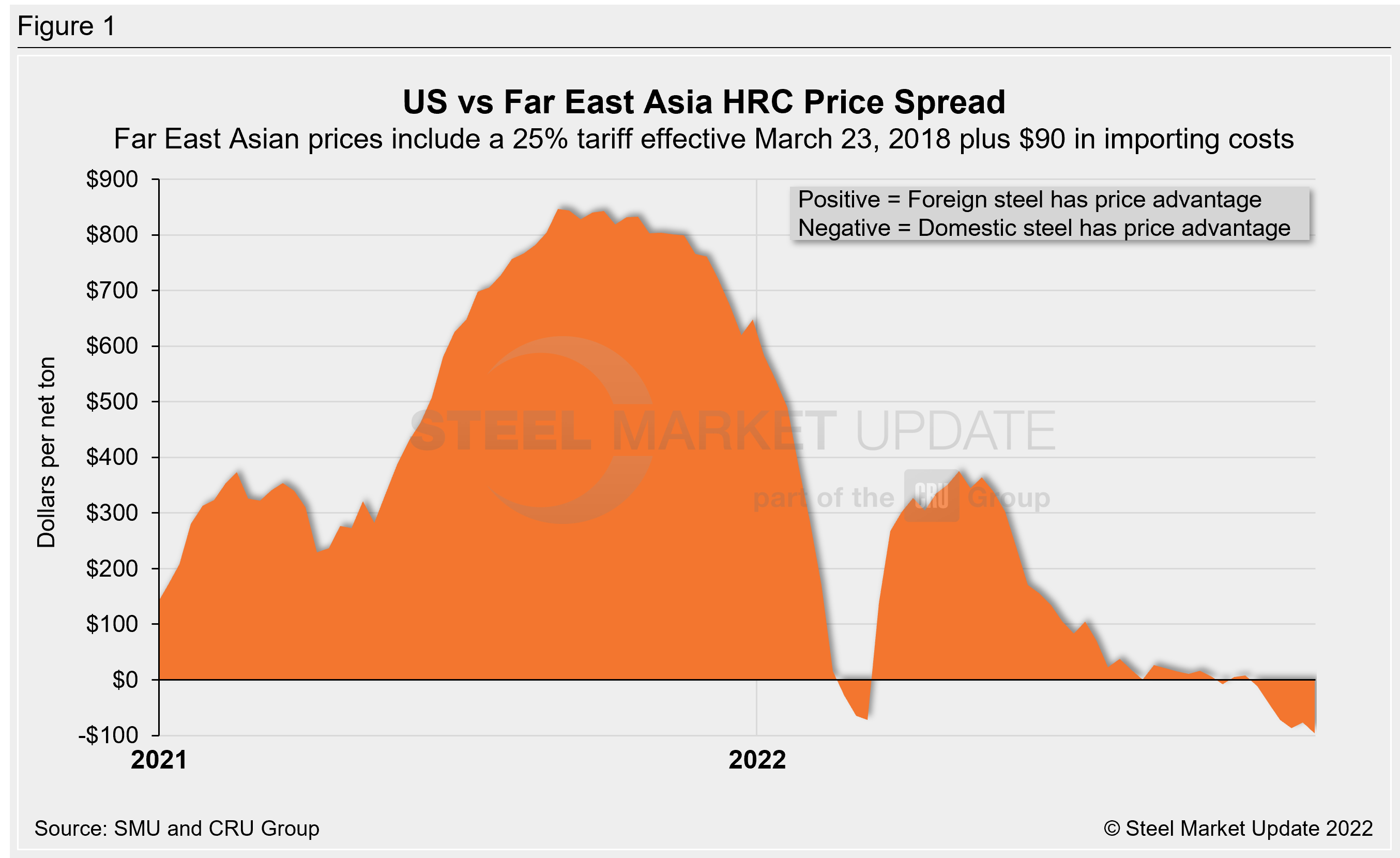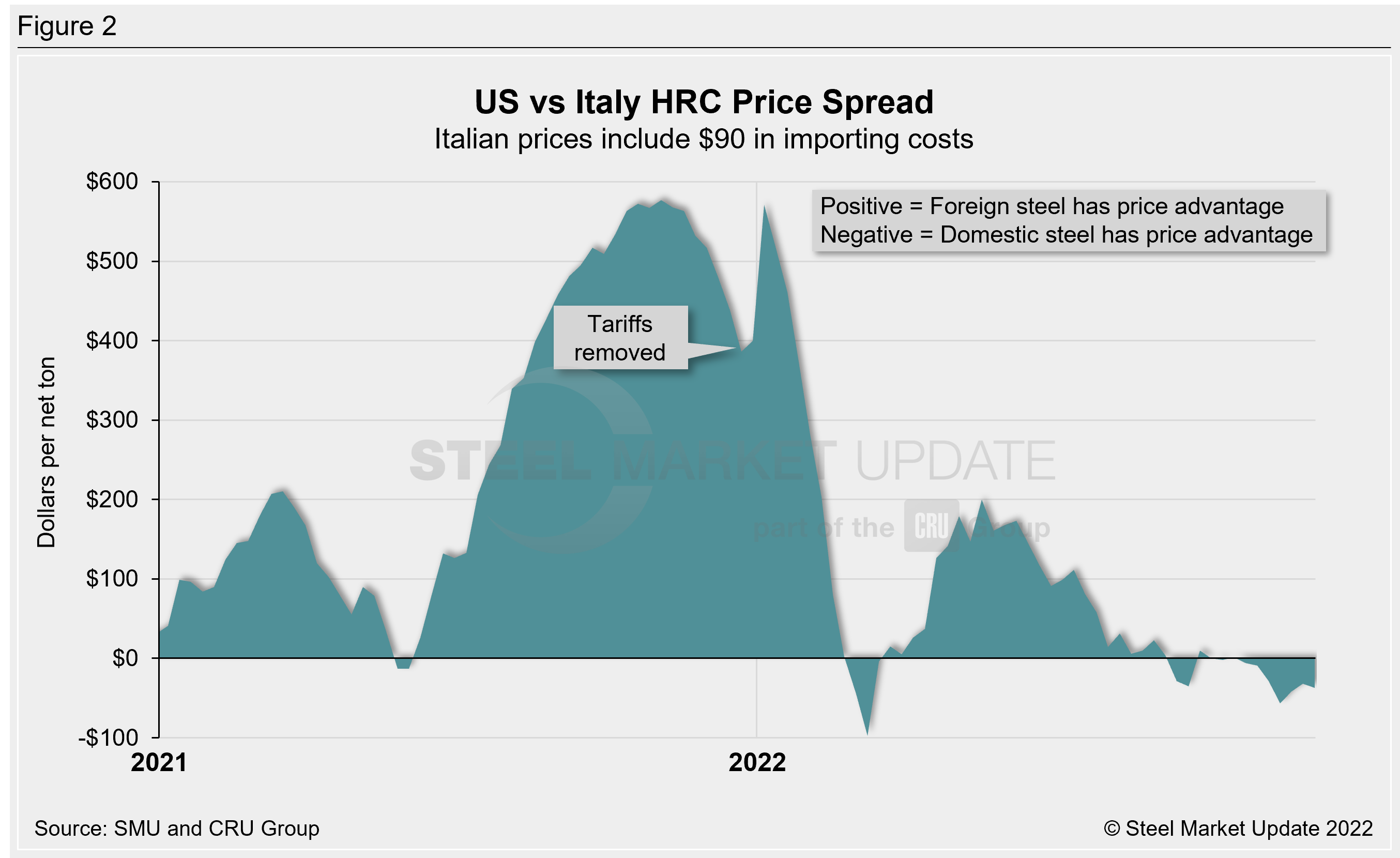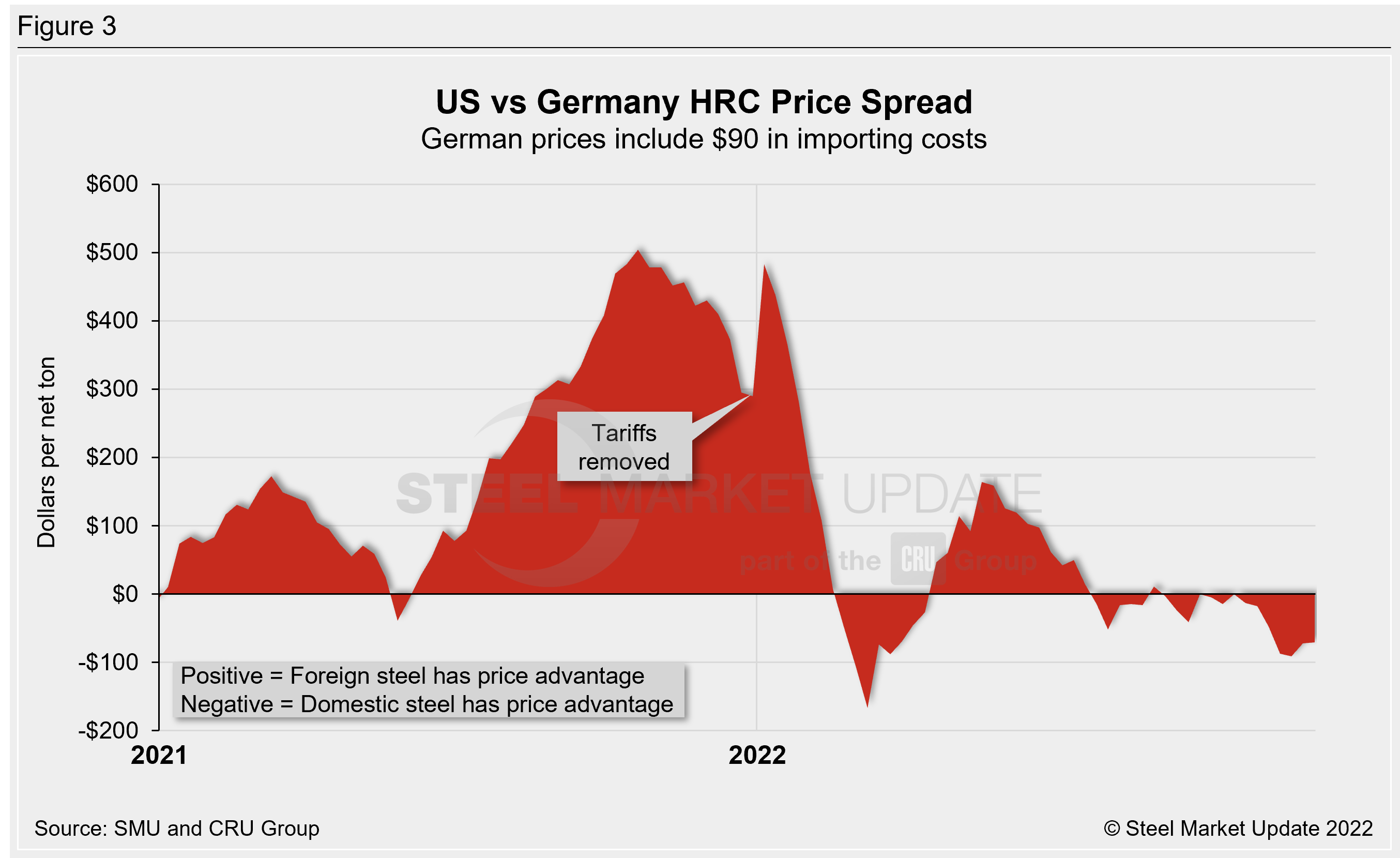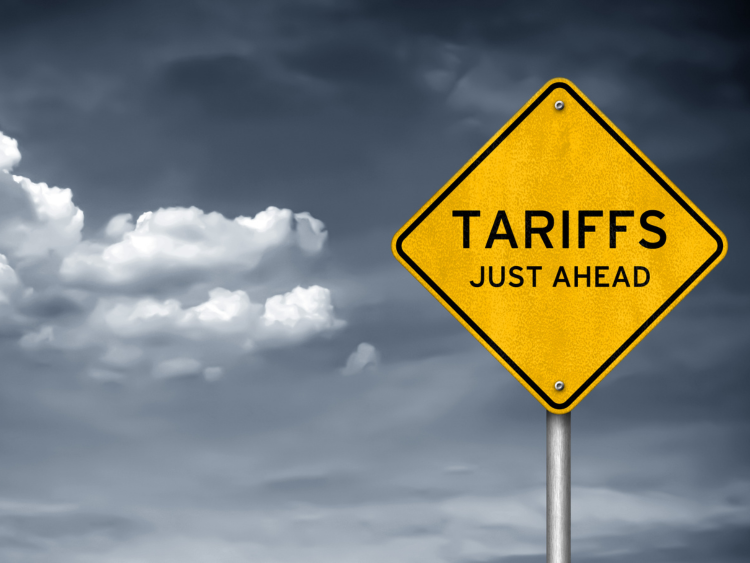Trade Cases

Domestic Hot-Rolled Coil Keeps Competitive Edge Over Import Prices
Written by Brett Linton
December 8, 2022
Domestic hot-rolled coil (HRC) continues to hold a competitive price advantage over imported steel, according to Steel Market Update’s latest foreign vs. domestic price analysis. US HRC is approximately 6–15% cheaper than foreign prices this week, after consideration of freight costs, trader margins, and any applicable tariffs. This is the sixth consecutive week US prices have been cheaper than foreign prices for all three regions we follow. HRC prices for all regions increased week over week, with the average spread growing from $60 per ton last week to $68 per ton this week.
![]() SMU uses the following calculation to identify the theoretical spread between foreign HRC prices (delivered to US ports) and domestic HRC prices (FOB domestic mills): Our analysis compares the SMU US HRC weekly index to the CRU HRC weekly indices for Germany, Italy, and Far East Asian ports. This is only a theoretical calculation because costs to import can vary greatly and often fluctuate, which influences the true market spread.
SMU uses the following calculation to identify the theoretical spread between foreign HRC prices (delivered to US ports) and domestic HRC prices (FOB domestic mills): Our analysis compares the SMU US HRC weekly index to the CRU HRC weekly indices for Germany, Italy, and Far East Asian ports. This is only a theoretical calculation because costs to import can vary greatly and often fluctuate, which influences the true market spread.
In consideration of freight costs, handling, and trader margin, we add $90 per ton to all foreign prices to provide an approximate “CIF US ports price” that can be compared against the SMU domestic HRC price. Buyers should use our $90-per-ton figure as a benchmark, adjusting it as necessary based on their own shipping and handling costs. If you have experience importing foreign steel and want to share your thoughts on these costs, we welcome your insight and comments: Brett@SteelMarketUpdate.com.
Far East Asian HRC (East and Southeast Ports)
As of Wednesday, Dec. 7, the CRU Far East Asian HRC price increased $27 per ton week over week to $517 per net ton ($570 per metric ton), up $32 from levels one month ago. Adding a 25% tariff and $90 per ton in estimated import costs, the delivered price of Far East Asian HRC to the US is $736 per ton. The latest SMU hot-rolled average is $640 per ton, up $15 from last week but down $15 vs. levels one month prior.
Therefore, US-produced HRC is now $96 per ton cheaper than steel imported from Far East Asia. This is now the largest price appeal that domestic HRC has had over Far East Asian HRC since September 2020. One month ago domestic prices held a discount of $42 per ton over foreign steel. Prior to October, Far East Asian prices had held the advantage since mid-March (the differential peaked at $375 per ton in May). The widest price advantage recorded for Far East Asian prices was just over a year ago, at $847 per ton in September 2021.

Italian HRC
Italian HRC prices increased $20 per ton week over week to $587 per net ton ($647 per metric ton) this week, $8 less than levels one month prior. After adding import costs, the delivered price of Italian HRC is approximately $677 per ton.
Domestic HRC is now theoretically $37 per ton cheaper than imported Italian HRC. Last week the spread was $32 per ton (with US prices holding the advantage). Three weeks ago we saw a spread of $57 per ton, the widest spread seen since March. One month ago, prices between these two regions were $29 apart, favoring US steel. The largest spread this year was $200 per ton in May when Italian prices held a considerable advantage. Before the removal of the 25% Section 232 tariff, the spread just over one year ago reached $577 per ton in November, the largest in SMU’s data history.

German HRC
CRU’s latest German HRC price increased $14 per ton week over week to $621 per net ton ($684 per metric ton), up $7 compared with levels one month ago. After adding import costs, the delivered price of German HRC is approximately $711 per ton.
Accordingly, domestic HRC is now theoretically $71 per ton cheaper than imported German HRC, almost identical to the spread one week prior. Two weeks ago prices between these regions were $91 per ton apart, the largest margin in favor of US prices seen since March. One month ago, domestic prices held a discount of $48 per ton over foreign steel. Domestic HRC has held this price advantage for all but three weeks since late July. German HRC held the price advantage for the three months prior to that, having reached a 2022 high of $164 per ton in May. Prior to the removal of the 25% tariff, the October 2021 spread of $504 per ton was the widest in SMU’s data history.

Figure 4 compares all four price indices and highlights the effective date of the tariffs. Foreign prices are referred to as “equalized,” meaning they have been adjusted to include importing costs (and tariffs in some cases) for a like-for-like comparison against the US price.

Figure 5 is simply a condensed version of Figure 4, focusing on HRC prices over the last nine months.

Notes: Freight is an important part of the final determination on whether to import foreign steel or buy from a domestic mill supplier. Domestic prices are referenced as FOB the producing mill, while foreign prices are CIF the port (Houston, NOLA, Savannah, Los Angeles, Camden, etc.). Inland freight, from either a domestic mill or from the port, can dramatically impact the competitiveness of both domestic and foreign steel. When considering lead times, a buyer must take into consideration the momentum of pricing both domestically and in the world markets. In most circumstances, domestic steel will deliver faster than foreign steel ordered on the same day.
Effective Jan. 1, 2022, the traditional Section 232 tariff no longer applies to most imports from the European Union. It has been replaced by a tariff rate quota (TRQ). Therefore, the German and Italian price comparisons in this analysis no longer include a 25% tariff. SMU still includes the 25% S232 tariff on foreign prices from other countries. We do not include any antidumping (AD) or countervailing duties (CVD) in this analysis.
By Brett Linton, Brett@SteelMarkeUpdate.com

Brett Linton
Read more from Brett LintonLatest in Trade Cases

Industry piles on new Section 232 steel derivative inclusion requests
The Department of Commerce received 97 submissions from producers, manufacturers, and groups seeking Section 232 tariff coverage for steel and aluminum derivative products.

Price on Trade: New EU steel tariffs don’t mean the US should weaken its stance
Any steel imports into the EU that exceed the new, lower quota level would be subject to a 50% tariff, which represents a major increase from the EU’s current 25% out-of-quota tariff. This move would largely align the EU’s steel tariff rate with Canada and the United States.

Global steel forum sets 2026 framework deadline as US ups pressure on excess capacity
Global steelmakers sounded the alarm Friday over the deepening excess steelmaking capacity crisis. Ministers at the Global Forum on Steel Excess Capacity (GFSEC) in Gqeberha, South Africa, pledged to...

CRU: China’s indirect steel exports find new destination markets
The boom in China’s direct steel exports has not stopped this year, even with a rise in protectionist measures globally. The increase is driven by...

U.S. Steel sues Algoma over iron pellet shipments
U.S. Steel is suing Algoma over the Canadian flat-rolled producer's rejection of iron pellet shipments, arguing it has breached its contract.
